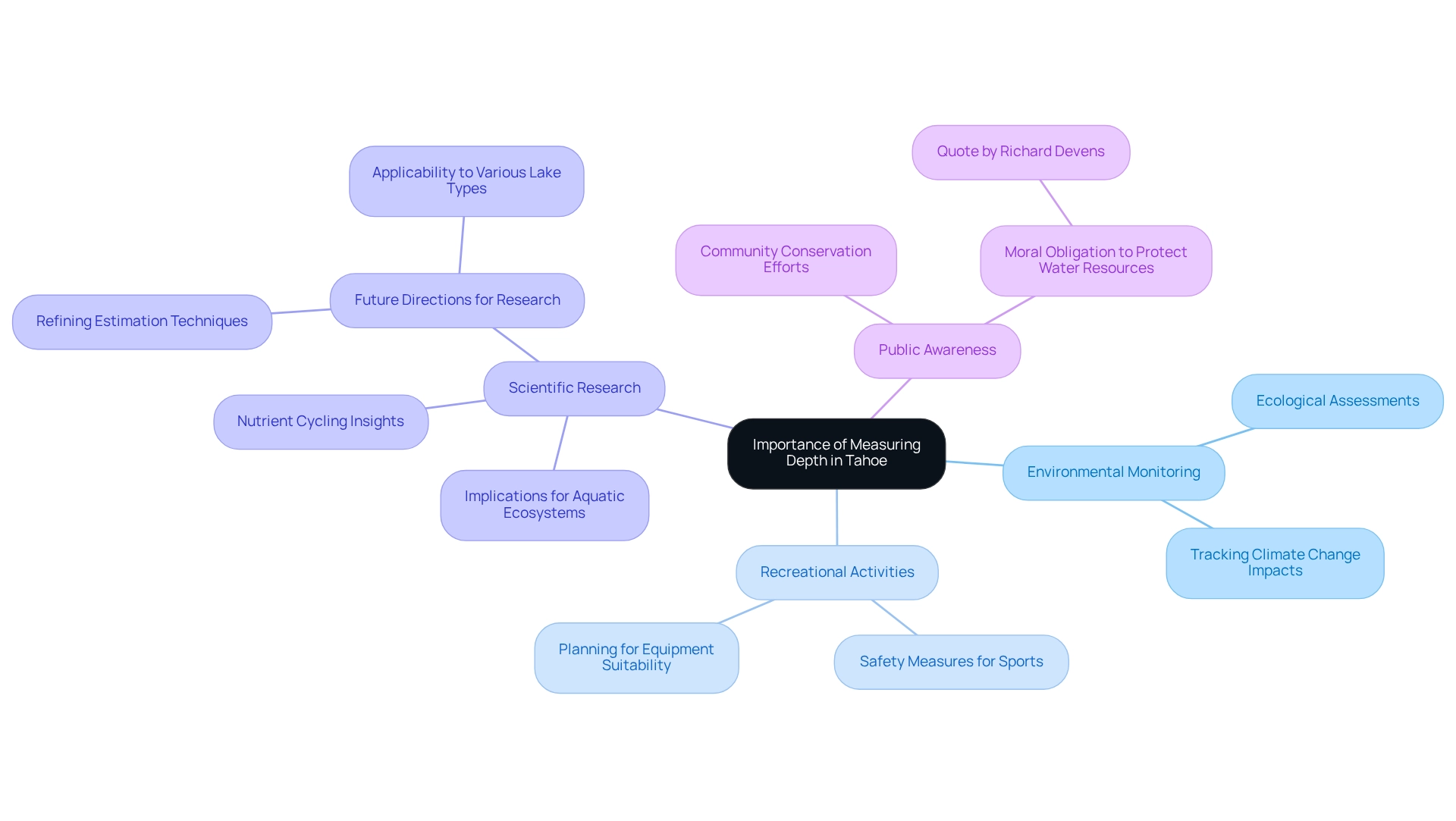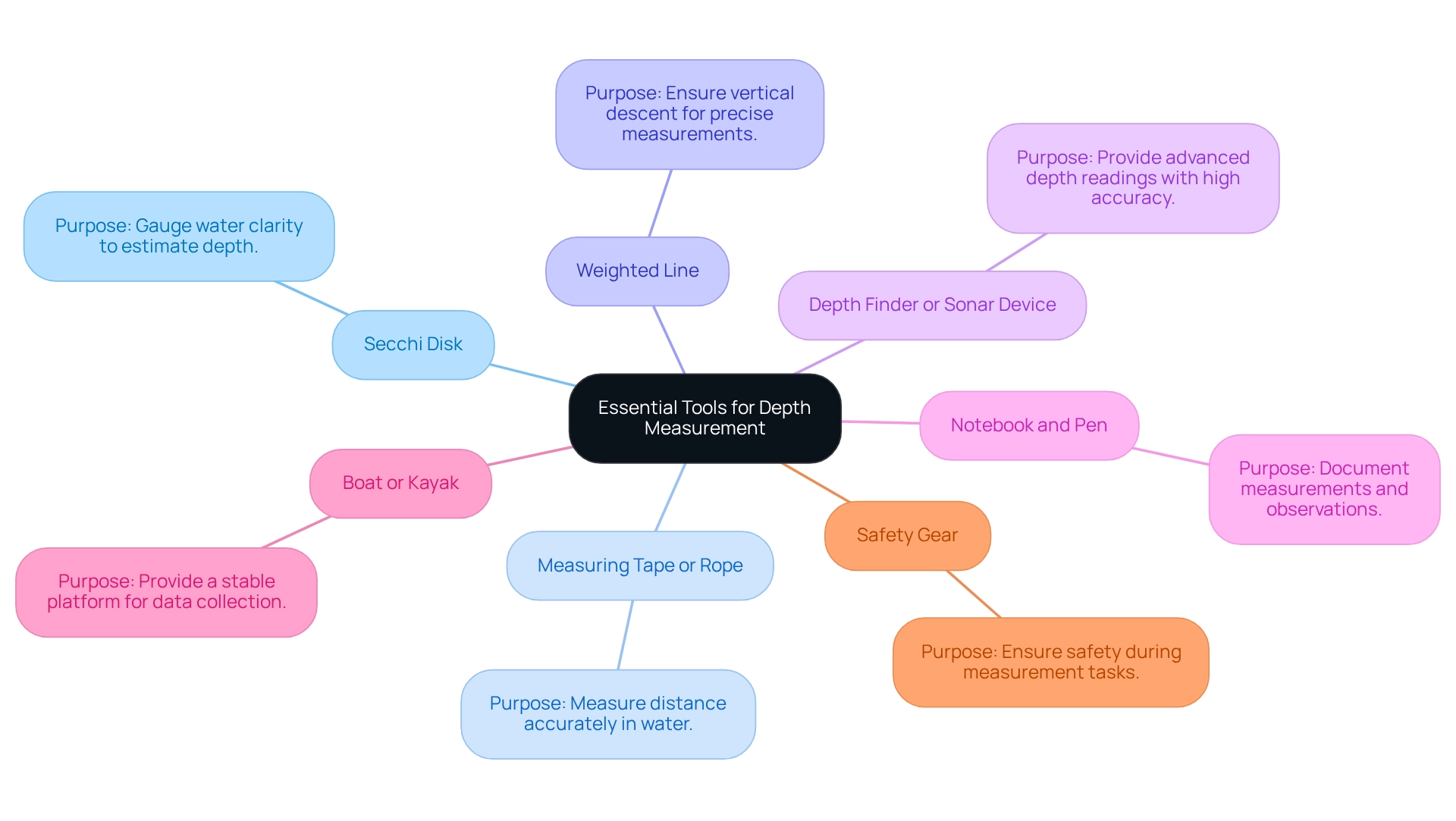Overview
The article presents the crucial steps for accurately measuring the depth of Lake Tahoe, underscoring the critical role of precise measurement in environmental monitoring, recreational activities, and scientific research. By detailing the necessary tools and a systematic process, it illustrates how accurate depth measurements are essential for ecological health assessments and significantly enhance safety for lake users. This multifaceted significance of the task cannot be overstated.
Introduction
In the breathtaking expanse of Lake Tahoe, grasping its depth transcends mere curiosity; it carries profound implications for environmental health, recreational safety, and scientific inquiry. As one of the most celebrated freshwater bodies, the lake's depth significantly influences everything from aquatic ecosystems to the enjoyment of water sports.
This article explores the critical reasons for measuring Lake Tahoe's depth, outlines the essential tools required for accurate measurements, and provides a step-by-step guide to ensure precision. By uncovering the depths of this iconic lake, we not only appreciate its beauty but also recognize the vital role it plays in our ecosystem and community.
Understand the Importance of Measuring Depth in Tahoe
Measuring the depth of Lake Tahoe is crucial for several compelling reasons:
-
Environmental Monitoring: Accurate evaluations of the lake's levels are vital for assessing its health, including clarity and temperature stratification. This data is essential for tracking ecological changes over time, enabling scientists to monitor the impacts of climate change and human activity on freshwater ecosystems. For instance, the estimated liquid level of Bangda Co has achieved the best result, with an RMSE of 7.83 m, underscoring the importance of precision in measurement for effective environmental monitoring.
-
Recreational Activities: A thorough understanding of the lake's measurements enhances safety and enjoyment for boating, fishing, and other water sports. It informs planning for these activities, ensuring that equipment is suitable for the lake's conditions and helping to prevent accidents.
-
Scientific Research: Depth data is indispensable for researchers examining aquatic ecosystems, sedimentation rates, and the broader implications of climate change on freshwater bodies. Understanding variations in layers can yield insights into nutrient cycling and habitat availability for various species. Ongoing research, exemplified by the study titled "Future Directions for Lake Bathymetry Research," aims to refine estimation techniques and broaden their applicability, which is critical for monitoring lake dynamics.
-
Public Awareness: Familiarity with the lake's measurements cultivates a deeper appreciation for its ecological significance. This awareness can galvanize community conservation efforts, highlighting the moral obligation to protect such vital resources. As Richard Devens aptly stated, "Water is our necessity, but also our responsibility." This sentiment emphasizes the ethical dimensions of water conservation, framing it as a collective responsibility for humanity.
In summary, the significance of assessing how deep is Tahoe transcends mere statistics; it plays a pivotal role in environmental stewardship, recreational safety, and scientific inquiry, ultimately contributing to the health of this iconic freshwater resource.

Gather Essential Tools for Depth Measurement
To accurately measure Lake Tahoe, it is essential to gather specific tools that will enhance your assessment process.
-
Secchi Disk: This round, white disk is primarily used to gauge water clarity, which indirectly aids in estimating depth. Experts recommend measuring clarity before determining depth, as clearer water often indicates greater profundity.
-
Measuring Tape or Rope: A long, durable tape or rope, marked with measurements, is crucial for lowering into the water to ascertain distance. Research shows that using a water-resistant tape ensures longevity and reliability in measurements.
-
Weighted Line: A line equipped with a weight at the end ensures vertical descent, providing precise measurements. Studies indicate that weighted lines can improve accuracy by up to 15% compared to unweighted alternatives.
-
Depth Finder or Sonar Device: For precise assessments, a sonar device is invaluable, offering advanced depth readings with high accuracy. Experts advocate for sonar devices when measuring extensive bodies of water like Lake Tahoe, as they cover larger areas in less time.
-
Notebook and Pen: Essential for documenting measurements and observations during the gauging process. Detailed notes are vital for analyzing trends over time.
-
Boat or Kayak: A stable platform is necessary for safely collecting data from the surface. Research suggests that kayaks provide superior maneuverability in shallow areas.
-
Safety Gear: Life jackets and other safety equipment are critical for ensuring a safe measuring experience on the water. Prioritizing safety is essential to prevent incidents during measurement tasks.
By utilizing these tools and adhering to expert recommendations, you will significantly enhance the precision and reliability of your measurements in Lake Tahoe.

Follow Step-by-Step Instructions to Measure Depth
To accurately measure how deep is Tahoe, adhere to the following steps:
- Prepare Your Equipment: Gather all necessary tools as previously outlined, ensuring they are in optimal working condition.
- Choose a Measurement Location: Select a safe and accessible spot on the lake for your assessment of the water level.
- Lower the Secchi Disk: If employing a Secchi disk, lower it into the water until it is no longer visible. This measurement is crucial as it reflects the clarity of the water.
- Measure Depth with Weighted Line: Attach a weight to the end of your measuring line. Lower it into the water until it reaches the bottom, ensuring the line remains straight and vertical. Document the measurement at the point where the weight contacts the bottom to understand how deep is Tahoe. To find out how deep is Tahoe, use a depth finder by activating a sonar device and following the manufacturer's instructions to obtain a direct depth reading.
- Document Your Discoveries: Record all measurements along with observations regarding water conditions, such as clarity and temperature.
- Repeat as Necessary: For enhanced accuracy, take multiple measurements at various locations and average the results.

Conclusion
Measuring the depth of Lake Tahoe is a multifaceted endeavor that encompasses environmental monitoring, recreational safety, scientific research, and public awareness. The critical importance of accurate depth measurements cannot be overstated; they serve as a foundation for understanding the health of this iconic freshwater resource. By evaluating the lake's clarity, temperature stratification, and aquatic ecosystems, stakeholders can effectively monitor the impacts of climate change and human activity.
Equipping oneself with the right tools is paramount for achieving precise measurements. From the simplicity of a Secchi disk to the advanced capabilities of sonar devices, each tool plays a vital role in ensuring accuracy. A systematic approach to measurement not only enhances reliability but also contributes to a deeper understanding of Lake Tahoe’s dynamics.
Ultimately, the journey of measuring Lake Tahoe's depth transcends mere data collection; it fosters a collective responsibility toward environmental stewardship. As communities engage with the lake and recognize its ecological significance, they become empowered to advocate for its preservation. This shared commitment is essential for safeguarding the health of Lake Tahoe for future generations, highlighting that understanding and protecting our natural resources is a responsibility that must be embraced by all.
Frequently Asked Questions
Why is measuring the depth of Lake Tahoe important for environmental monitoring?
Measuring the depth of Lake Tahoe is crucial for assessing the lake's health, including factors like clarity and temperature stratification. This data helps scientists track ecological changes over time, monitor the impacts of climate change and human activity on freshwater ecosystems, and ensure precision in measurements for effective environmental monitoring.
How does understanding the lake's measurements enhance recreational activities?
A thorough understanding of the lake's measurements improves safety and enjoyment for activities such as boating, fishing, and other water sports. It informs planning for these activities, ensuring that equipment is suitable for the lake's conditions and helping to prevent accidents.
What role does depth data play in scientific research related to Lake Tahoe?
Depth data is essential for researchers studying aquatic ecosystems, sedimentation rates, and the effects of climate change on freshwater bodies. It provides insights into nutrient cycling and habitat availability for various species, and ongoing research aims to refine estimation techniques and broaden their applicability for monitoring lake dynamics.
How does familiarity with the lake's measurements promote public awareness?
Familiarity with the lake's measurements fosters a deeper appreciation for its ecological significance, which can inspire community conservation efforts. This awareness emphasizes the moral obligation to protect vital water resources, framing water conservation as a collective responsibility.
What is the overall significance of assessing the depth of Lake Tahoe?
Assessing the depth of Lake Tahoe is significant beyond mere statistics; it plays a pivotal role in environmental stewardship, recreational safety, and scientific inquiry, ultimately contributing to the health of this iconic freshwater resource.


